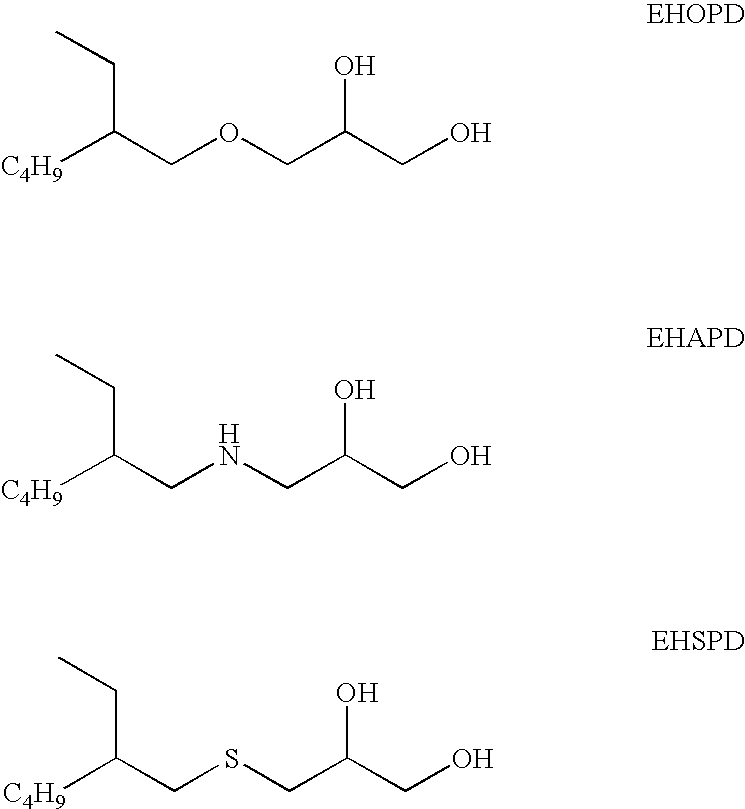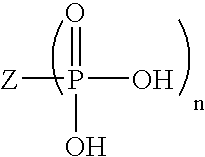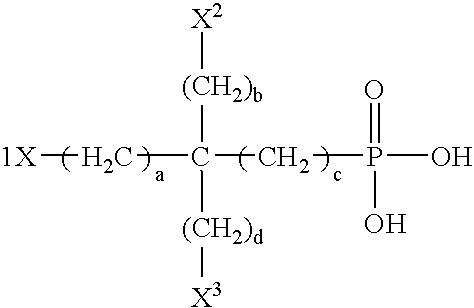Ophthalmic Compositions Comprising A Branched, Glycerol Compound
a technology of glycerol and compound, which is applied in the field of ophthalmic compositions comprising branched, glycerol compound, can solve the problems of difficulty in selecting two or more antimicrobial compounds, and achieve the effect of reducing the use of cationic antimicrobial components and enhancing the biocidal efficacy of aqueous ophthalmic compositions
- Summary
- Abstract
- Description
- Claims
- Application Information
AI Technical Summary
Benefits of technology
Problems solved by technology
Method used
Image
Examples
example 1
[0052]The log reduction of microorganisms with 10% organic soil for 3-[(2-ethylhexyl)oxy]-1,2-propanediol (EHOPD) in borate buffered saline is shown in Table 1
TABLE 1Biocidal data for EHOPD in Borate Buffered SalineConc.TimeS.P.S.C.F.(wt %)(hr)aureusaeruginosamarcescensalbicanssolani0.000111.41.51.72.31.341.41.51.72.32.10.00111.41.51.72.31.941.41.51.72.31.90.0111.42.61.72.32.441.4>5.01.72.3>5.80.111.7>5.04.85.4>5.844.0>5.0>5.2>5.7>5.80.511.8>5.04.95.1>5.844.3>5.0>5.2>5.7>5.8
example 2
[0053]The log reduction of microorganisms with 10% Organic Soil for EHOPD in phosphate buffered saline is shown in Table 2.
TABLE 2Biocidal Data for EHOPD in Phosphate Buffered SalineConc.TimeS.P.S.C.F.(wt %)(hr)aureusaeruginosamarcescensalbicanssolani0.000111.41.51.72.32.341.41.51.72.32.30.00111.41.51.72.31.841.41.53.22.32.90.0111.41.5>5.22.33.641.41.5>5.22.3>5.80.111.41.5>5.23.8>5.843.03.7>5.2>5.7>5.80.511.41.5>5.23.8>5.843.14.1>5.2>5.7>5.8
example 3
[0054]The biocidal efficacy of EHOPD is also evaluated for multi-purpose lens care formulation detailed in Table 3A. The log reduction values of microorganisms with 10% organic soil for the multi-purpose lens care formulations of Table 3A with varying concentrations of EHOPD are detailed in Table 3B.
TABLE 3ACompound(wt %)Sodium Phosphate (monobasic)0.23Sodium Phosphate (dibasic)0.77Sodium Chloride0.19(30%) Hydroxyalkylphosphonate0.10Poloxamer 4072.0Poloxamine 11071.0Polyquaterium-100.02EHOPD0.01 to 1.0WaterQ.S. to 100%
[0055]The biocidal data from Examples 1, 2 and 3 indicate that EHOPD exhibits significant activity against all of the microorganisms in the study, and thus is useful as an antimicrobial component for preservation or disinfection efficacy in ophthalmic compositions.
PUM
| Property | Measurement | Unit |
|---|---|---|
| Fraction | aaaaa | aaaaa |
| Fraction | aaaaa | aaaaa |
| Fraction | aaaaa | aaaaa |
Abstract
Description
Claims
Application Information
 Login to View More
Login to View More - R&D
- Intellectual Property
- Life Sciences
- Materials
- Tech Scout
- Unparalleled Data Quality
- Higher Quality Content
- 60% Fewer Hallucinations
Browse by: Latest US Patents, China's latest patents, Technical Efficacy Thesaurus, Application Domain, Technology Topic, Popular Technical Reports.
© 2025 PatSnap. All rights reserved.Legal|Privacy policy|Modern Slavery Act Transparency Statement|Sitemap|About US| Contact US: help@patsnap.com



